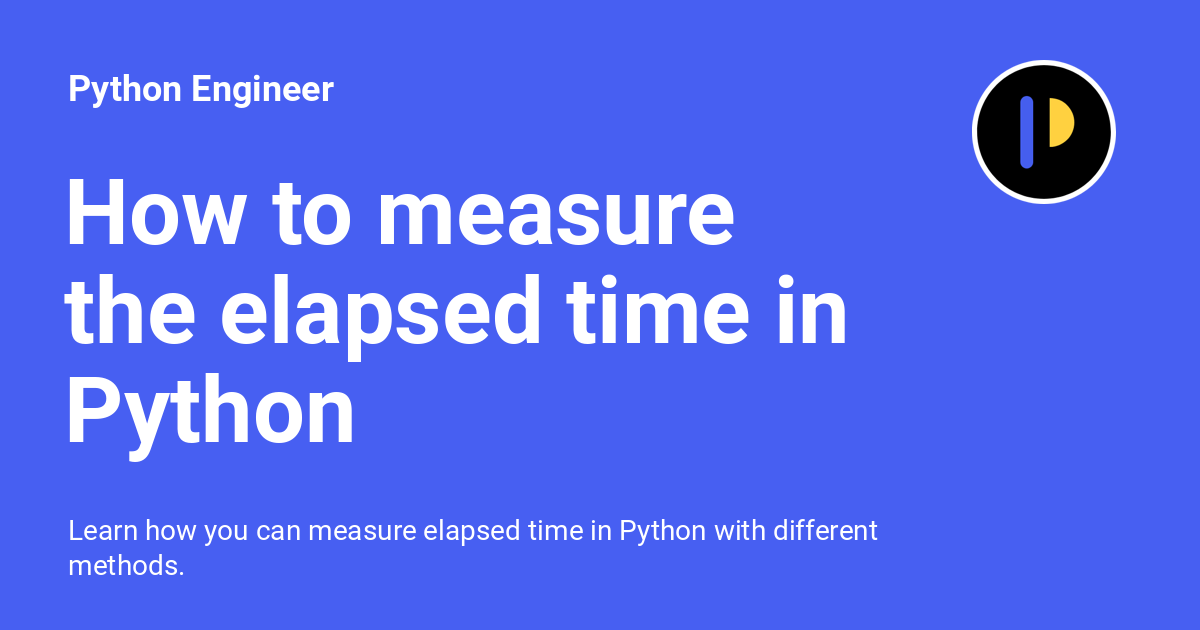Measure Elapsed Time in Python: A Guide
Learn different methods to accurately measure the execution time of your Python code snippets for performance optimization and analysis.
Learn different methods to accurately measure the execution time of your Python code snippets for performance optimization and analysis.
In this article, we'll explore how to measure the execution time of your Python code using the time module. This can be incredibly useful for identifying bottlenecks and optimizing your code for better performance. We'll break down the process into six simple steps, from importing the necessary module to calculating and displaying the elapsed time. Let's get started!
Import the time module: This module provides time-related functions.
import timeGet the starting time: Use time.time() to record the current time before your code executes.
start_time = time.time()Run your code: Place the code you want to measure the execution time of after the starting time capture.
# Your code here
print("hello")Get the ending time: Use time.time() again to record the time immediately after your code finishes.
end_time = time.time()Calculate the elapsed time: Subtract the starting time from the ending time.
elapsed_time = end_time - start_timePrint or use the elapsed time: The elapsed_time variable now holds the execution time in seconds.
print(f"Elapsed time: {elapsed_time} seconds")This will output the time it took to execute the code between the start and end time captures.
This Python code measures the execution time of a code snippet. It records the start and end times using the time module, calculates the difference, and prints the elapsed time in seconds.
import time
# Get the starting time
start_time = time.time()
# Your code here
print("Hello")
time.sleep(2) # Simulate some work that takes time
# Get the ending time
end_time = time.time()
# Calculate the elapsed time
elapsed_time = end_time - start_time
# Print the elapsed time
print(f"Elapsed time: {elapsed_time} seconds")Explanation:
import time: Imports the time module to access time-related functions.start_time = time.time(): Records the current time in seconds since the epoch (a reference point in time) and stores it in the start_time variable.print("Hello") and time.sleep(2): This is the code we want to measure. The print function outputs "Hello" to the console, and time.sleep(2) pauses the execution for 2 seconds to simulate some work.end_time = time.time(): Records the current time again after the code execution.elapsed_time = end_time - start_time: Calculates the difference between the ending and starting times, giving us the elapsed time in seconds.print(f"Elapsed time: {elapsed_time} seconds"): Prints the calculated elapsed time in a user-friendly format.Now, when you run this code, it will print "Hello", wait for 2 seconds, and then output the elapsed time, which will be approximately 2 seconds plus a tiny overhead for the other operations.
time.time() is generally sufficient for measuring code execution, for extremely precise measurements in performance-critical applications, consider using time.perf_counter() or time.process_time() for more accurate results.timeit module provides more robust and statistically sound ways to time small code snippets by running them multiple times.This guide outlines how to measure the execution time of your Python code using the time module:
| Step | Description | Code |
|---|---|---|
1. Import time module |
Provides time-related functions. | import time |
| 2. Get starting time | Record the time before your code runs. | start_time = time.time() |
| 3. Run your code | Place the code to be measured here. | # Your code here |
| 4. Get ending time | Record the time after your code finishes. | end_time = time.time() |
| 5. Calculate elapsed time | Subtract starting time from ending time. | elapsed_time = end_time - start_time |
| 6. Use elapsed time | The elapsed_time variable holds the execution time in seconds. |
print(f"Elapsed time: {elapsed_time} seconds") |
This simple method allows you to analyze the performance of your code by measuring how long it takes to execute.
Understanding how to measure the execution time of your code is fundamental for writing efficient Python programs. By leveraging the time module and its functions, you can pinpoint bottlenecks, compare different approaches, and ultimately optimize your code for better performance. Whether you're a beginner or an experienced developer, these techniques are valuable tools in your Python arsenal.
 How to Measure Elapsed Time in Python | Guide on measuring elapsed time in Python. Includes simple code examples.
How to Measure Elapsed Time in Python | Guide on measuring elapsed time in Python. Includes simple code examples. How to measure elapsed time in Python? - GeeksforGeeks | A Computer Science portal for geeks. It contains well written, well thought and well explained computer science and programming articles, quizzes and practice/competitive programming/company interview Questions.
How to measure elapsed time in Python? - GeeksforGeeks | A Computer Science portal for geeks. It contains well written, well thought and well explained computer science and programming articles, quizzes and practice/competitive programming/company interview Questions. Here is how to measure elapsed time in Python in Python | Here is how to measure elapsed time in Python in Python. ... In Python, you can use the time module to measure elapsed time. You can use the time() function to ...
Here is how to measure elapsed time in Python in Python | Here is how to measure elapsed time in Python in Python. ... In Python, you can use the time module to measure elapsed time. You can use the time() function to ... How to measure the elapsed time in Python - Python Engineer | Learn how you can measure elapsed time in Python with different methods.
How to measure the elapsed time in Python - Python Engineer | Learn how you can measure elapsed time in Python with different methods. Measuring Elapsed Time in Python | Measuring elapsed time in Python involves capturing start and end timestamps using the time module, then calculating the difference to…
Measuring Elapsed Time in Python | Measuring elapsed time in Python involves capturing start and end timestamps using the time module, then calculating the difference to… Python Program to Measure the Elapsed Time in Python | In order to calculate the time elapsed in executing a code, the time module can be used. The execution time depends on the system.
Python Program to Measure the Elapsed Time in Python | In order to calculate the time elapsed in executing a code, the time module can be used. The execution time depends on the system. Measure elapsed time in Python | Sentry | The Problem How can I measure the execution time of my Python code? The Solution We can do this using the perf_counter function in Python's built-in time…
Measure elapsed time in Python | Sentry | The Problem How can I measure the execution time of my Python code? The Solution We can do this using the perf_counter function in Python's built-in time… Measure elapsed time and time differences in Python | note.nkmk.me | In Python, to measure elapsed time or to calculate the time difference between two date-times, use the standard library's time module and datetime module. Elapsed time and time differences can be repr ...
Measure elapsed time and time differences in Python | note.nkmk.me | In Python, to measure elapsed time or to calculate the time difference between two date-times, use the standard library's time module and datetime module. Elapsed time and time differences can be repr ...